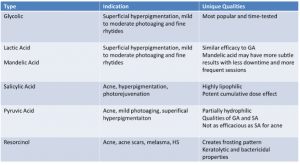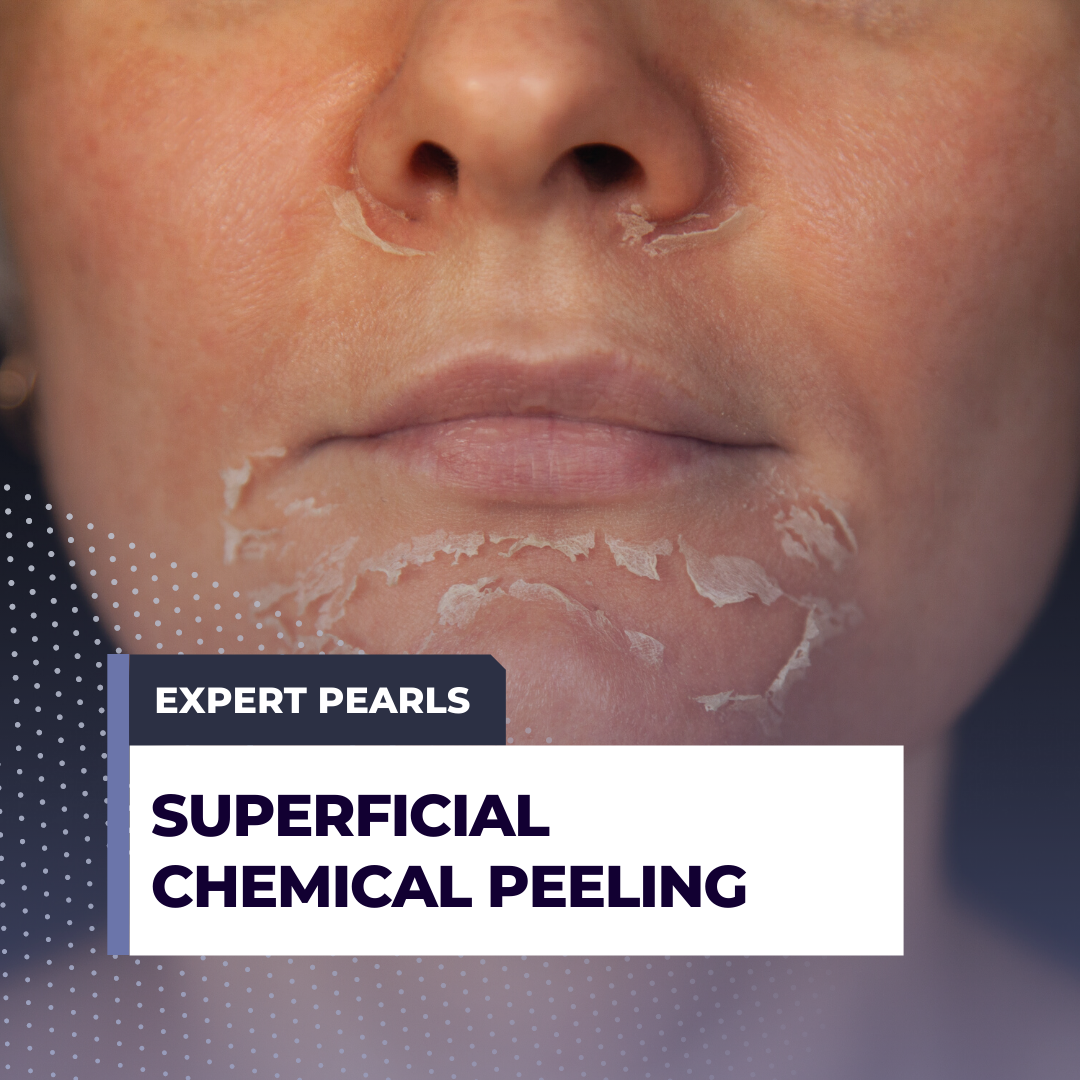Chemical peels are the third most commonly performed noninvasive cosmetic procedure in the United States, with over 1 million peels performed annually.
Peels can treat a variety of skin conditions including acne, conditions of hyperpigmentation, and skin irregularities from chronic sun damage. Multiple peels on a repeated basis are usually necessary to obtain optimal results. The frequency of peels and degree of exposure to the peeling agent may be increased gradually as necessary. Generally, 3-6 peels are recommended every 3-4 weeks for best results. Results can be enhanced by medical or cosmeceutical therapy. All superficial chemical peels share the advantages of minimal to no symptoms during application as well as minimal downtime needed for recovery. Peeling and redness usually resolves within a few days but may last up to 7 days.
Pearl: Superficial peels can be used in all skin types and can help improve penetration of topical regimens.
The goal of superficial peels is to treat conditions confined to epidermis while minimizing downtime and risk of side effects. This is achieved by inducing controlled epidermal damage, which results in new collagen deposition and enhanced skin appearance.
Patient Evaluation
It is important to complete a cosmetic consultation and consider several criteria for patient selection.
Considerations: Obtain a thorough medical history and ensure no active inflammatory skin conditions prior to initiating therapy with peels. Medications such as exogenous estrogens, oral contraception and photosensitizing medications can increase the risk of pigmentary changes.
Contraindications:
-
- Pregnancy & Lactation
- Active infection or open wounds in treatment area(s)
Types of Superficial Peels
-
- Alpha hydroxy acids (AHAs):
- Glycolic (20-50%)
- Lactic (10-30%)
- Mandelic (40%)
- Alpha hydroxy acids (AHAs):
-
- Beta hydroxy acids (BHAs):
- Salicylic (30%)
- B-lipohydroxy acid
- Pyruvic, alpha keto (50%)
- Beta hydroxy acids (BHAs):
-
Pearl: Avoid salicylic peels in rosacea as it may exacerbate redness.
-
- Retinol
- Lactic
- Jessner’s
- Resorcinol (10-50%)
- TCA (10-20%)
Indications for Superficial Peels:

Factors Affecting Peel Depth
-
- Peeling agent and concentration
- Number of layers
- Contact time with the skin
- Application technique
- Prepping of the skin (degreasing and topical maintenance regimen with retinoids)
Pre-Peel Considerations
Sun protection is the most important pre-and post-procedure element! For patients with FST IV-VI or a history of post-inflammatory hyperpigmentation, Hydroquinone and Tretinoin may be used adjunctively as part of their regimen, particularly if there is concern for post-inflammatory hyperpigmentation. Retinoids should be stopped 5 days before the procedure day. The goal is to thin the stratum corneum, improve penetration of the peel, decrease post-inflammatory hyperpigmentation, and accelerate healing.
Let’s get your steps down!
-
- Gentle cleanser to remove make-up, sebum, oil and cellular debris
- Degrease skin with alcohol or acetone
- Protect danger areas with petroleum jelly:
- Medial and lateral canthi, periapical triangles of the nose, lateral oral commissures
Technique is key! For best results, ensure uniform application of the peeling agent. Use firm even strokes to apply the peel in an upward direction and avoid overlapping brush strokes or skipping areas. Using a feathering technique at the edges of the treatment field will avoid sharp demarcation lines. Most superficial peels need 1-3 coats to reach the desired endpoint (erythema and/or frosting). AHA peels require prompt neutralization. TCA is self-neutralizing but duration of time to self-neutralize exceeds time needed to achieve desired keratocoagulation, therefore it is recommended that TCA peels be neutralized once desired peel depth is achieved to prevent further unwanted coagulation.
Post-Peel Guidelines
Apply cool compresses to treated areas followed by an emollient with mineral sunscreen. After 24 hours, encourage routine cleansing with gentle cleanser and daily emollients. Advise patients not to pick, rub, or scratch the skin. Patients can restart their prior topical regimen after 3-5 days.
Summary:
-
- Superficial chemical peels are a useful tool for cosmetic and medical conditions
- Superficial peels offer cost-effective, safe and efficacious adjuvant therapy for a variety of conditions
- Superficial peels are well tolerated and can help improve efficacy of topical regimens
This information was presented by Dr. Nada Elbuluk at the 2022 ODAC Dermatology, Aesthetic and Surgical Conference held January 14-17, 2022. The above highlights from her lecture were written and compiled by Dr. Mojgan Hosseinipour.
Did you enjoy this article? Find more on Chemical Peels here.

